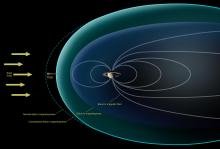Listen to today's episode of StarDate on the web the same day it airs in high-quality streaming audio without any extra ads or announcements. Choose a $8 one-month pass, or listen every day for a year for just $30.
You are here
Moon and Saturn
The strongest winds on Earth top out at more than 200 miles per hour — the winds at the hearts of powerful hurricanes. Yet the winds on the solar system’s giant outer planets make that sound like a gentle breeze. Winds on Saturn, for example, can reach more than a thousand miles per hour — the fastest winds measured on any planet. What’s more, those winds blow all the time, not just during big storms.
Saturn is in the southeast at first light right now, and looks like a bright golden star. Tomorrow, it stands just below the crescent Moon, making it an especially easy target.
The strongest winds on Saturn are at the equator. They blow from west to east, at speeds that are always in the hundreds of miles per hour, and sometimes faster. They’re powered by the planet’s fast rotation and by its internal heat; Saturn radiates more than twice as much energy into space as it receives from the Sun.
The heat may come from a “rain” of liquid helium tens of thousands of miles below Saturn’s cloud tops.
Saturn has a lower percentage of helium in its atmosphere than any of the other giant planets. That suggests that the helium has fallen deep into Saturn. Models show that the helium forms droplets. As they descend, the energy of their fall is converted to heat. That warms Saturn’s interior. Some of the heat then rises back toward the surface, where it drives Saturn’s weather — including the most powerful winds in the solar system.
Script by Damond Benningfield






